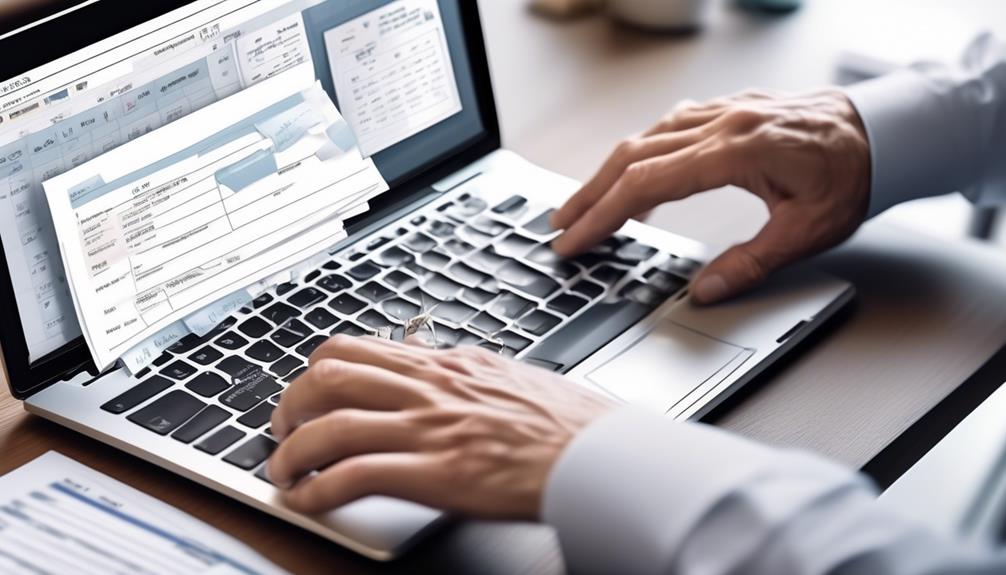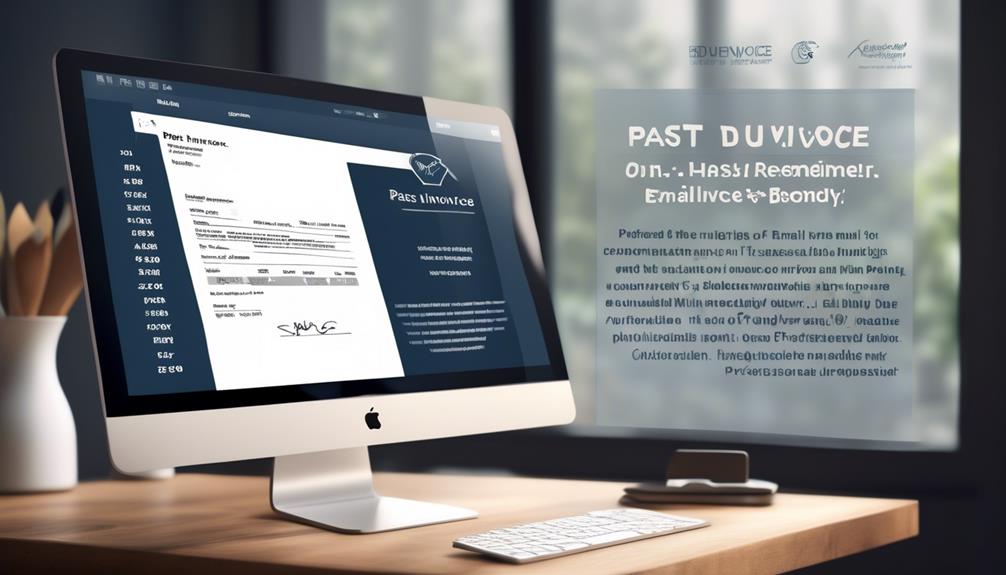We’ve all experienced it – drafting an email for an overdue invoice is no easy feat. It’s essential to find the perfect mix of firmness and professionalism, all while preserving the rapport with your client.
However, navigating this delicate situation requires finesse and tact. So, how do we ensure that our emails are effective in prompting action without damaging the client relationship?
Well, let's explore some key strategies for crafting a past due invoice email that gets results while preserving the goodwill with your clients.
Key Takeaways
- Crafting a compelling past due invoice email is essential to effectively communicate with clients about overdue payments.
- It is important to convey a friendly yet firm tone in the email, clearly stating the overdue amount, original payment deadline, and late fees.
- Providing payment options and outlining the consequences of non-payment can encourage prompt payment.
- Following up with multiple past due invoice emails, escalating the urgency, and involving sales representatives or account managers can help in resolving non-payment issues.
Understanding Past Due Invoices
Understanding past due invoices is crucial for maintaining healthy cash flow and ensuring timely payments. As businesses, we need to grasp the impact of late payments on our financial well-being. Late payments cost global businesses over $3 trillion, underscoring the significance of addressing past due invoices proactively.
To tackle this issue, we must implement effective strategies such as crafting compelling past due invoice emails, offering payment plans, and establishing a clear late fee policy. Moreover, personalized past due invoice emails tailored to different client subgroups can enhance our communication and collection efforts.
We also need to be aware of the option to engage a collections agency if necessary, but it's vital to exhaust all internal avenues before taking this step. By comprehending the intricacies of accounts receivable and the various factors that contribute to overdue invoices, we can develop comprehensive approaches to invoice payment and prevent the accumulation of unpaid invoices.
Our understanding of past due invoices is the cornerstone of our ability to navigate this complex landscape and maintain a healthy cash flow.
Crafting an Effective Email

Crafting an effective email for past due invoices requires clear and concise communication to prompt timely payment from the client. When composing overdue payment reminder emails, it's crucial to convey a friendly yet firm tone.
Clearly state the overdue amount, the original payment deadline, and any applicable late fees. Offering payment options and outlining the consequences of continued non-payment can also encourage prompt action. Including a link or instructions for making payments directly from the email can streamline the process for the client and potentially expedite the resolution of the late payment.
Additionally, reiterating the potential impact of late payment on future services or collaborations can serve as a gentle yet persuasive reminder. Crafting an effective email also involves being mindful of the recipient's time, so keep the message brief and to the point.
Timing and Frequency of Emails
To effectively prompt timely action from clients with overdue invoices, the first past due invoice email should be sent as soon as the due date passes. This initial email serves as a gentle reminder and opens the communication channel regarding the late payment. Subsequent to this, it is crucial to follow up at 30, 60, and 90 days with formal, bold, and clear-cut emails, respectively, for effective communication. These follow-ups should escalate in urgency to convey the seriousness of the situation.
| Timing | Email Content |
|---|---|
| 0-30 days | Polite reminder |
| 30-60 days | Firm follow-up |
| 60-90 days | Strong demand for payment |
| 90+ days | Warning of late fees |
| Beyond 90 days | Final notice of consequences |
It's essential to establish a consistent email workflow with multiple follow-ups to engage late payers effectively. Additionally, utilizing alternative templates like reminders, nudges, and final notices for varied communication frequencies can also be beneficial. For corporate clients, consider involving sales representatives or account managers for personalized communication, as this can often yield better results. By implementing a well-structured timing and frequency strategy, you can greatly increase the likelihood of receiving payment for overdue invoices.
Strategies for Dealing With Non-Payment

After establishing a consistent email workflow with multiple follow-ups to engage late payers effectively, it's crucial to address strategies for dealing with non-payment.
When it comes to non-payment, it's important to take proactive steps to ensure that you get paid quickly and efficiently. Here are some strategies to consider:
- Offer Payment Plans
Providing clients with the option to pay in installments can help alleviate financial strain and increase the likelihood of receiving payment.
- Enforce Late Fees
Clearly outline your late fee policy in your initial agreement and enforce it when payments are overdue. This can serve as a deterrent for future late payments.
In addition to these strategies, sending a formal letter as a final notice can convey the seriousness of the situation. If necessary, you may need to consider legal action or other consequences for non-payment.
Preventing Future Late Payments
Establishing clear payment terms and due dates in your invoices is essential for preventing future late payments. Clearly outlining the expectations for payment in your terms and conditions can help avoid misunderstandings and disputes. Additionally, consider including a statement regarding late fees for overdue payments to incentivize clients to adhere to the agreed-upon timeline.
When sending out invoices, ensure the email subject clearly indicates that it's an invoice and includes the due date to prompt timely action. Offering convenient payment options, such as credit card payments or online transfers, can make it easier for clients to fulfill their financial obligations promptly. Moreover, providing flexible payment plans for larger invoices can help clients manage their cash flow and reduce the likelihood of late payments.
It's also important to follow up on late invoices promptly and professionally, sending reminders and implementing a structured process for dealing with overdue payments. By proactively addressing potential payment issues and streamlining the invoicing process, you can significantly reduce the occurrence of late payments and promote healthier financial relationships with your clients.
Frequently Asked Questions
How Do You Say Something Is Past Due in an Email?
We make it clear that something is past due in an email by stating the specific overdue item or service, the original due date, and the current amount owed.
Using a respectful yet firm tone, we emphasize the urgency of the situation and offer assistance if needed.
A direct subject line and a professional approach are crucial.
If necessary, we follow up with a phone call or a formal notice to ensure prompt resolution.
How Do You Politely Ask for a Past Due Payment?
We approach this delicate situation like expert gardeners nurturing a flower to bloom.
We politely ask for the past due payment by sending a direct yet gracious email, offering clear payment options and contact information.
Our mastery in communication ensures a tactful approach, prompting timely payment without damaging the client relationship.
It's crucial to adapt to each client's situation and involve relevant teams for support, like skilled artisans crafting a masterpiece.
How Do You Say Your Invoice Is Overdue?
We kindly inform clients when their invoice is overdue by sending a polite reminder email. It's vital to maintain professionalism and clarity while emphasizing the urgency of payment.
Our approach involves using firm but respectful language to convey the overdue status and provide clear instructions for settling the outstanding balance. This ensures that clients understand the situation and are prompted to take immediate action to address the overdue invoice.
How Do You Ask for Overdue Payment Professionally in an Email?
We approach requesting overdue payment professionally in an email by emphasizing clarity and respect. We outline the amount due, the original due date, and any relevant invoice details.
We offer alternative payment solutions if needed and ensure our subject line stands out. Remaining professional and composed, we communicate the urgency without becoming emotional.
Our approach paints a clear picture and fosters understanding, fostering a positive response from our clients.
Conclusion
Just as a skilled sailor navigates through stormy seas to reach their destination, crafting an effective past due invoice email is essential in steering the course of business relations towards smoother waters.
By understanding the nuances of communication and timing, we can weather the challenges of non-payment and prevent future late payments, ultimately guiding our business towards success and stability.










